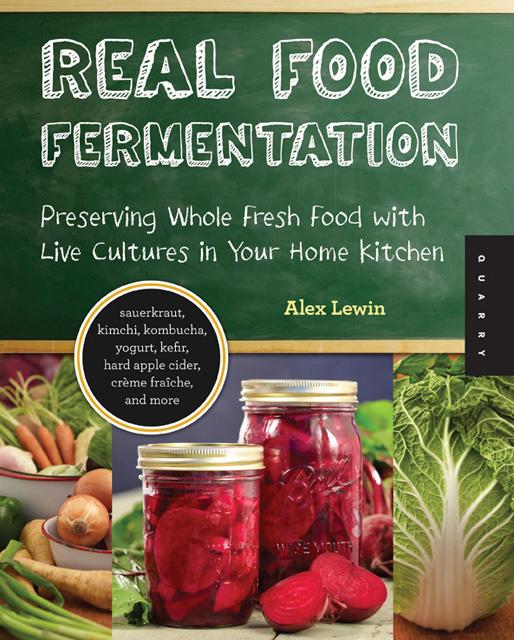If you follow my blog then you know I have a special affinity toward fermented foods. I did a three part series: What Are Fermented Foods? My absolute go-to source for making my own fermented vegetables has been the cookbook Real Food Fermentation by Alex Lewin. I learned better techniques from this cookbook than I did from Nourishing Traditions! I even shared Alex’s method for fermenting vegetables in my post on that topic before I even knew him! Alex Lewin’s cookbook provides very simple and step by step instructions with beautiful photos on how to make all kinds of fermented foods.
Luckily, I was recently able to do an interview with the author which I can now share with you! Hopefully it will help you get started. I am also happy to share that I am doing a giveaway of 2 COPIES of this book to 2 lucky readers! Alex will also be monitoring the comments on the blog today and if you have any questions at all, please post them and he will answer them! You couldn’t find the better time to take the plunge with fermenting!
This giveaway is a part of a Blog Tour – meaning that today you are visiting my blog and tomorrow you’ll want to head on over to www.honesttogoodnessliving.com for her post and giveaway. The next day there will be another blog…and so on!
Now, don’t forget to read through to the bottom and then enter via the Rafflecopter for your chance to WIN 1 of 2 Real Food Fermentation books that I am giving away!
What is the name of your book, including subtitle?
My book is entitled Real Food Fermentation: Preserving Whole Fresh Food with Live Cultures in Your Home Kitchen.
“Real Food” is for me the opposite of “phony food”. The world is overrun with phony food: mass-produced processed stuff that resembles traditional food, but is quite different when you really look at it. Phony food is made with chemicals instead of care and time, and can hurt our bodies in subtle and not-so-subtle ways. It is time to get back to real food.
“In Your Home Kitchen”, because my recipes are designed to be easy for home cooks. The recipes don’t require unusual equipment or advanced skills. Most of what you need is already in your kitchen, and the rest is easy to find and is inexpensive.
How long have you been fermenting?
When I first tasted kimchi, I was fascinated by it, because I love spicy food and garlicky food, and there’s nothing quite like kimchi in the typical American diet. I started making kimchi around 2004 or 2005. I found a recipe and followed it pretty closely–this much vegetable, this much salt, brine it for this long, etc. It wasn’t until a couple of years later, probably 2006, that I read Sandor Ellix Katz’s groundbreaking book, Wild Fermentation, and started to understand a bit about how fermentation works. Gradually I developed my own fermenting habits and tastes. Eventually I started doing demos, leading workshops, and teaching classes.
What makes your book different from other books on fermenting? Who would enjoy or benefit most from this book?
Real Food Fermentation is the best-looking fermentation book out there. When I say this, I am not blowing my own horn, since I can’t take credit for the book’s beauty; this credit belongs to the book’s designer, photographer, and publisher! (Thanks Regina, Glenn, and Quarry!) So if you like delicious-looking food books, this is a good one.
The pictures, besides being pretty, make the recipes easy to follow.
Because of this, I think my book is ideal for first-time fermenters; for folks who are not always confident in the kitchen; and for people who are visual learners, who like seeing something in addition to reading about it.
What are some good tips for a beginner?
Here are my tips:
- Do it now! Don’t wait until later. Don’t overthink it. Don’t get fancy. Buy a cabbage, find some jars (old food jars will do), and make some sauerkraut today.
- On a related note: let sauerkraut be your first fermenting project, even if you think you don’t like sauerkraut. You may be surprised. And sauerkraut is easy to get right, so it’s a confidence-builder.
- Keep it simple. Just make the plain version. Once you get a feel for it, you can start getting fancy.
- Share the love. Don’t be shy with your fermented foods. Even if they were easy to make, most people don’t make them. So next time you’re going to someone’s house for dinner, instead of bringing yet another bottle of wine, bring some of your home made sauerkraut!
- Be creative about serving. Try putting sauerkraut in soups and stews, on sandwiches, on a pizza, as a side, in your eggs, in your Bloody Mary…
When and where will your book be available?
My book is available now, in many stores, including many independent book and craft stores and all the usual online suspects. Right now you can order it through Amazon on sale for $14.73 – saving about $10 off the retail price of $24.99. Also, check your local independent book store and please consider buying my book from them, or having them order it for you if they don’t have it in stock. By doing this, you’ll be helping your bookstore survive in a world that is increasingly hostile to local, independent businesses of any kind, never mind bookstores!
Now, doesn’t that make you want to get started? So get entered to win one of 2 Real Food Fermentation Books below! And don’t forget to head over to www.honesttogoodnessliving.com tomorrow!
a Rafflecopter giveaway
This post featured on: Allergy Free Wednesday, Real Food Wednesday, Simple Lives Thursday, Fight Back Friday











Hi! I love making sauerkraut and am confident as I grew up with it, I know what to do, what it should look, smell and feel like at any stage. The opposite is true about me making kefir. I just got some grains by post, they were travelling in a ziplock bag (not dehydrated) and arrived smelling of milk gone bad, as opposed to sour milk. I have washed them with milk and eventually with water to get rid the smell, they are in a third batch of milk after transport and though the “wrong” smell is much weaker, it is still there. How can I revive them? Have they suffocated? Thank you very much for any pointers!
If it smells moldy (like a dirty sponge) then throw it out. I have had that happen before and it never got better. Three batches should be enough time to right itself. 🙁
THank you Lindsey, I tried to remember dirty sponge smell, I dont think it is that… How does your kefir smell and taste? I would love as many analogies and poetic descriptions as possible 🙂
Mine smells yeasty just like Alex said and it tastes like milk soda – I say that because it is effervescent. Amazing really. It is drinkable not like yogurt at all but when I strain it, it does have a jiggly texture until I push it through the strainer to homogenize it. However, I am also using raw milk and when the grains start growing it throws the ratio off – @facebook-2368:disqus and tips on grains to milk ratio? what do you do when they just start growing like crazy? I end up with different results all the time. Sometimes it is thinner and sometimes thicker. I try to keep it to 24 hours but sometimes it ferments faster and sometimes it is too long. I know real food isn’t consistent so not asking for that! but am asking for any tips for keeping things a bit more steady. thanks!
I’ve never been too picky about grains to milk ratio…I don’t know, a Tbsp or two to a quart? It depends a lot on your particular colony of kefir grains, so as you point out it’s hard to say anything definitive! I try to filter out my grains when it’s still easy to filter, before the milk itself has started to separate. I’ll try to err on the side of straining too soon. I do this purely because it’s easier. Then I’ll often leave the kefir out on the counter for a while more (without grains). I find this just makes the whole thing easier. I find straining kind of stressful because I confuse kefir grains with globs of fat etc.
If you have too many grains–give them to someone! Or use them for experiments with fermenting other things, and see how it goes. Or eat them. 🙂
What she said. Mold is bad.
But be aware that kefir is “weirder” than yogurt. It does have a yeasty smell to it, and that’s normal, since it contains yeasts. I would say that it can smell like spoiled milk.
And the kefir you make at home is a completely different beast from the kefir you can buy at the store. Don’t use store-bought kefir as a reference point, even a little bit.
And…whenever dealing with fermentation stuff, remember to use non-chlorinated water, since chlorine kills microbes. You may know this , you may not, other readers may or may not know this, I thought I would say it in case it helps someone! Brita filters do the trick (although there are reasons that folks might want to use other kinds of filters—but that’s a whole other topic!).
Thank you for the comment! I am not sure its a dirty sponge smell, more like funny cheese, going direction goat milk maybe. The guy who sent me the grains said when he got them, they smelled strongly of goats milk, as the lady who sent them used only raw goat milk. How do I know kefir is good to drink? I dont mind weird taste, I just dont know what it should taste like. My only experience is with soviet mass produced kefir and with powdered culture kefir. I use raw milk. How important is the temperature of milk I put the grains into?
Hi Masha, I’m not convinced that there’s anything wrong with your kefir. A goat/cheese smell is okay. It’s pretty unlikely that you’ll make yourself sick by trying it, even if it is off. Where are you? Do you have other folks you could taste it with? That would take some of the fear out of it! 🙂
As far as temperature, it’s great if it’s room temp, but it’s fine if it’s a little cooler. If it’s straight out of the fridge I might warm it up first. Once you have it in a glass container, put the container in a water bath and swirl it around a bit to take the chill off…
Your book sounds great! I love fermented foods, especially sauerkraut but it does not love me. Any suggestions for lessening the after effects? Might fresh and not processed, store bought kraut be the answer? Thanks!
Are you saying that store-bought sauerkraut gives you gas? If so, you may be in luck! Here’s why:
There are basically two kinds of sauerkraut. There’s the (a) “chop it up and dump vinegar on it” kind, and there’s the (b) “chop it up, add salt or a starter, and let it ferment” kind. Most store-bought kraut is type (a), because it’s way faster and easier. But if you fermented it yourself, it’s type (b).
Cabbage contains complex sugars and starches. When they get broken down into simple sugars, gas is produced in the process. With type (a) sauerkraut, this happens in your large intestine! With type (b), it mostly happens during the fermentation process.
So I’d suggest that you try making it yourself, and see how it goes. And I’d recommend that you let it ferment for a while, if you want to reduce the potential for unpleasantness. Start with two weeks maybe?
Hope this helps!
That’s what I was talking about! Thank you so much for the explanation and I look forward to trying to make my own.
I’m getting ready to ferment for the first time; I’m planning on doing sauerkraut and water kefir! I’m normally very confident in the kitchen, never shying away from trying a nre flavor or technique, but I must admit, I’m a little nervous about fermenting. Probably because there is a fine line between a good ferment and a rancid gonna make you sick, lol and I have no point of reference, I’ve never tasted homemade kraut and didn’t know what kefir even was until about 3 weeks ago. In all of my preparations I’ve tried to gather some solid “basics” to keep in mind, such as slice you cabbage super thin, as thin as you can get it, and don’t let your fermenting water kefir (especially grape) get too warm otherwise it makes a fantastical bang, with a fantastical mess! Thinking back to when you were first learning to ferment, was there one piece of advise or tidbit of knowledge that made you say/think “Now THAT would have been nice to know beforehand”? Thank you so much Mr. Lewin for any insights you may be able to offer towards this new journey I am getting ready to take myself and my family on. Also thank you to both Mr. Lewin and Homemade Mommy for sponsoring this awesome Q&A and giveaway!
This is awesome Danielle! I have had batches go ‘off’ – You can mostly tell when they are bad – if they are black or something. I have a batch right now thought that seems to have some white stuff in it and I think it is mold. not sure why it happened but it happens sometimes! Just toss it and go again. This is why I like to do small batches because I would hate to have to throw out an entire crock! One rule of thumb I have heard over and over again is to never put your kefir next to your fermenting veggies as they can cross contaminate.
Did not know that! That’s a really good tidbit, thank you!
To add to what Lindsey said…
Do keep fermenting things away from potential sources of contamination, if you can. That can include other fermenting things. It can also include shoes and socks, even fruit bowls or fresh fruit and if you tend to neglect them and let them get moldy, as I sometimes do. 🙁
Other tips?
Have faith. Cabbage and humans were made for each other. Sauerkraut is not a stretch, or even a coincidence. You are not trying to make it do something weird; you are helping it to fulfill its destiny. It just needs a little guidance from you.
Fresh cabbage, salt without any weird additives, clean jars, pack it down until the liquid rises, open it and pack it down every day for the first few days…it should work out just fine! And taste it along the way, and start eating it when it tastes good to you. Or let it go for a long time and see if you like it even more!
If you make different batches different ways, take notes so you can see what works best for you.
Put masking tape on your jars and write dates on it.
Good luck!
Thank you Alex. What about white sediment on the bottom? Is that ok?
Sediment is normal.
Great advise! Thank you so much!
I am just learning about fermenting. I make my own yogurt but would love to start learning about fermenting other foods. I have a digestive disease and don’t do well with sauerkraut. Can you recommend any other vegetables that would be better for me?
What kind of sauerkraut were you eating that didn’t agree with you?
Lindsey asks what kind of kraut. This is a great question. In a previous response (see below) I talked about store-bought, vinegar kraut vs. home-made, fermented kraut. Obviously the home-made is better. 🙂
When you say you don’t do well with sauerkraut, do you mean it is hard for you to digest? There are two main potential issues that I know of–starches and sugars, and fiber. Fermenting helps a lot with the starches and sugars, but not as much with the fiber. If yogurt works for you and home-made kraut does not, then it may be a fiber issue.
I really recommend to everyone a book called “The Fiber Menace”. We’ve all been trained to believe that more fiber = better. This is not true! For a lot of people, especially folks with digestive diseases, fiber can be a disaster. The intro and first chapter of this book are posted here: http://www.gutsense.org/fibermenace/fm_intro.html http://www.gutsense.org/fibermenace/fm_chapter1.html
Hope this helps.
I’ve made yogurt but I would love to learn how to ferment veggies!
If anyone is in the Austin area – I have kefir grains to share right now too!
I have made kombucha, but sometimes I let it ferment too long. Is there anything I can do with it if it is too strong for us to drink (rather than throw it out) ? Sauerkraut will be the next ferment I will try.
I often wind up with kombucha that is too sour. Sometimes even a day one way or the other can make the difference. I hate throwing it away.
When it gets too sour, basically you can use it anywhere you would use vinegar and/or apple cider.
So sometimes I’ll add water and drink it, not as a “fun” drink but as a tonic first thing in the morning. (Some people do this with raw apple cider vinegar.)
You can use it as a probiotic salad dressing, with oil and herbs and whatever.
You can use it as a marinade.
If you cook it down, it can make a nice flavoring for a sauce for pork, scallops. (I have used it with monkfish and skate, too, but I can’t recommend them because they are not sustainably caught…see http://www.montereybayaquarium.org/cr/SeafoodWatch/web/sfw_factsheet.aspx )
I have read that when kefir ferments too long that it can be constipating and if it ferments too short a time then it can give you diarrhea – is this true or an old wives tale?
(do you mean kefir or kombucha?)
I meant kefir
Hmm. I haven’t heard this, but I can speculate:
Fresh milk, especially pasteurized, homogenized, “industrial” milk, does give some people diarrhea. So kefir that is not fermented for long enough could too–but it shouldn’t be any worse than what you might get from the milk itself. So I think there may be a grain (!) of truth to this one, although if you are using better milk, it shouldn’t be an issue.
Kefir fermented too long being constipating? Again, milk can be constipating to some people, and for them, kefir might be too, although given how much more digestible kefir is than milk, it seems like a stretch…
So I think the story you heard is incomplete at best…
Your book looks great, and thanks Homemade Mommy for this post and opportunity! Due to dairy sensitivities in my family, we are making coconut kefir instead of regular raw milk kefir. Any particular recommendations that I should follow or special tips on coconut milk and brands that you recommend? I’m using the organic Whole Foods 365 brand in a can for now since it’s the only one I’ve found that doesn’t have additives, other than trace amounts of guar gum. I did get a sample of the So Delicious brand that has limited additives but haven’t tried it yet.
Best of course is if you can buy a young coconut and tap it yourself. 🙂 It’s a little more work, but it’s worth it.
I’ve seen young coconuts for sale at Whole Foods, also at various ethnic markets. They’re usually a couple of bucks, so not that far off from buying it in cans. And you can eat the coconut flesh–delicious!
Be aware that young coconut and mature coconut are different, and that coconut water and coconut milk are different. I suppose you could kefir either of them, but I think it’s usually the water that’s used.
If you can’t get fresh, my favorite is “Amy & Brians”. No additives, tastes best to me. I like it with pulp, but if you’re making kefir, the pulp could get in the way…
Just to clarify – @facebook-694270905:disqus is using milk kefir grains not water kefir grains and is kefiring coconut milk…just looking and I don’t see any Amy and Brian’s coconut milk or coconut water…is that correct?
Here’s Amy and Brian’s: http://amyandbriannaturals.com/Index.html
What they call “coconut juice” I call “coconut water”.
There’s no particular reason dairy kefir grains would prefer coconut milk over coconut water. Hard to generalize. Whatever works!
Is it possible to add too much salt and whey to the kraut? I thought I had more cabbage than I did, and I added probably twice as much as I should have of salt and whey. What does this do to the kraut?
Well…too much salt will make slow down the fermentation and make it too salty. Too much whey will speed up the fermentation and may give it a slight dairy taste. I woud say, if you have some spare veggies sitting around, why not add them? Otherwise maybe add some water (non-chlorinated). Or you could add some water, shake it up, and then dump out some of the water, to get less salt and less whey.
All in all, best play may be to let it do its thing, see how it goes, and if it’s too salty, add water later until it tastes good.
The bottom line: it may not be a problem…and you can probably fix it later.
Thanks so much!
This is a great way to learn about new blogs plus I could use the book!
Alex — I always seem to have an issue with the very top of the sauerkraut getting a bit “yucky’ — it has not-so-good bacteria and I always scoop it out, but it grosses me out! What do you suggest to keep everything submerged when you are using a mason jar? Thanks, Maryanne
Hi Maryanne. I usually make sauerkraut in mason jars, and each day for the first few days, I pack it down until the top gets submerged completely. For me, this is usually enough to keep my sauerkraut happy, even the bits on the top. I tend to use narrow half-pint or three quarter-pint jars for packing.
Other things you might try are adding supplementary brine, and/or weighting down the kraut with some inert object(s) like dishes or (clean) stones. Some people use ziplock bags filled with water as weights, but I wouldn’t do this in the long term, because the acidity could break down the plastic.
Oooh I can do that (packing down the stuff each day)?? I’ve always been afraid to open my jars until after a few days (I’m a newbie in fermenting veggies and have been following the simple method in Nourishing Traditions.) I can’t wait to read your book!
I have been looking into fermentation, I want to start but my kids and hubby are picky… A great recipe book would be soooo helpful. Thanks
If I don’t have space in the fridge to store lots of ferments, what temperature should my cold pantry be?
The cooler it is, the slower things will ferment. Below 40° is basically like a fridge. 55° is like burying it in the ground, and in Korea they keep kimchi like this for months and months…
There’s no “right” temperature, but the warmer it is, the more the ferments will continue to ferment. They will get more sour and less crunchy, and at some point, depending on your taste, you may not like them quite as much.
(But If I had to pick a number, I’d say 58° or lower would be good for medium-term storage.)
If my milk kefir grains start to color (pinkish) are they bad?
Sorry to hear that! Pinkish doesn’t sound good to me. I just searched for “kefir grains pink” on the Internet. Sounds like some sort of contamination. You could throw them out. Or you could try what one site suggests, which is rinsing them off, putting them in fresh water for 24 hours, making a batch of kefir but chucking it, and then resuming where you left off. Good luck!
I have tried a few ferments and have read such varied advice on the length of time to leave your ferment from 2 days to 2 months! Also, you MUST use whey to you SHOULD NOT use whey as it is a dairy product…I am confused to say the least! Thanks for your time
Alex, What is your favorite thing to ferment? I would like to try sauerkraut and corned beef (Yay Reuben!!). I would like to try yogurt too. kristiedonelson(at)gmail(dot)com Thank you.
Alex, is it better to use “starter” or whey? Really hope I win the book, been wanting to try fermenting for awhile! 🙂
I would love to try keifer, since my toddler loves it. Alex, what does a beginning fermenter need to know about food safety?
I’m dying to try kefir. What’s the best way to start?
The book sounds great. I’ve only tried fermenting homemade ketchup and making homemade yogurt (3 times). I tried homemade sauerkraut, but the directions I followed (from a nutritionist’s blog) seemed to take on more odor than ferment. Thanks for the opportunity to win a free copy.
I’m wanting to start kraut…I just ordered this book. i have Sally Fallon’s Book and Sander’s Book “The Art of Fermentation”. I’m a little confused with all the different ways to do it and am concerned. Sally says to just put it in a mason jar, pound it down, and then seal it. No adding water or anything. Others say sealing is bad and you need to make sure it all stays submersed in liquid. Any advice or suggestions? I don’t want to be afraid to try my creations anymore! 🙂